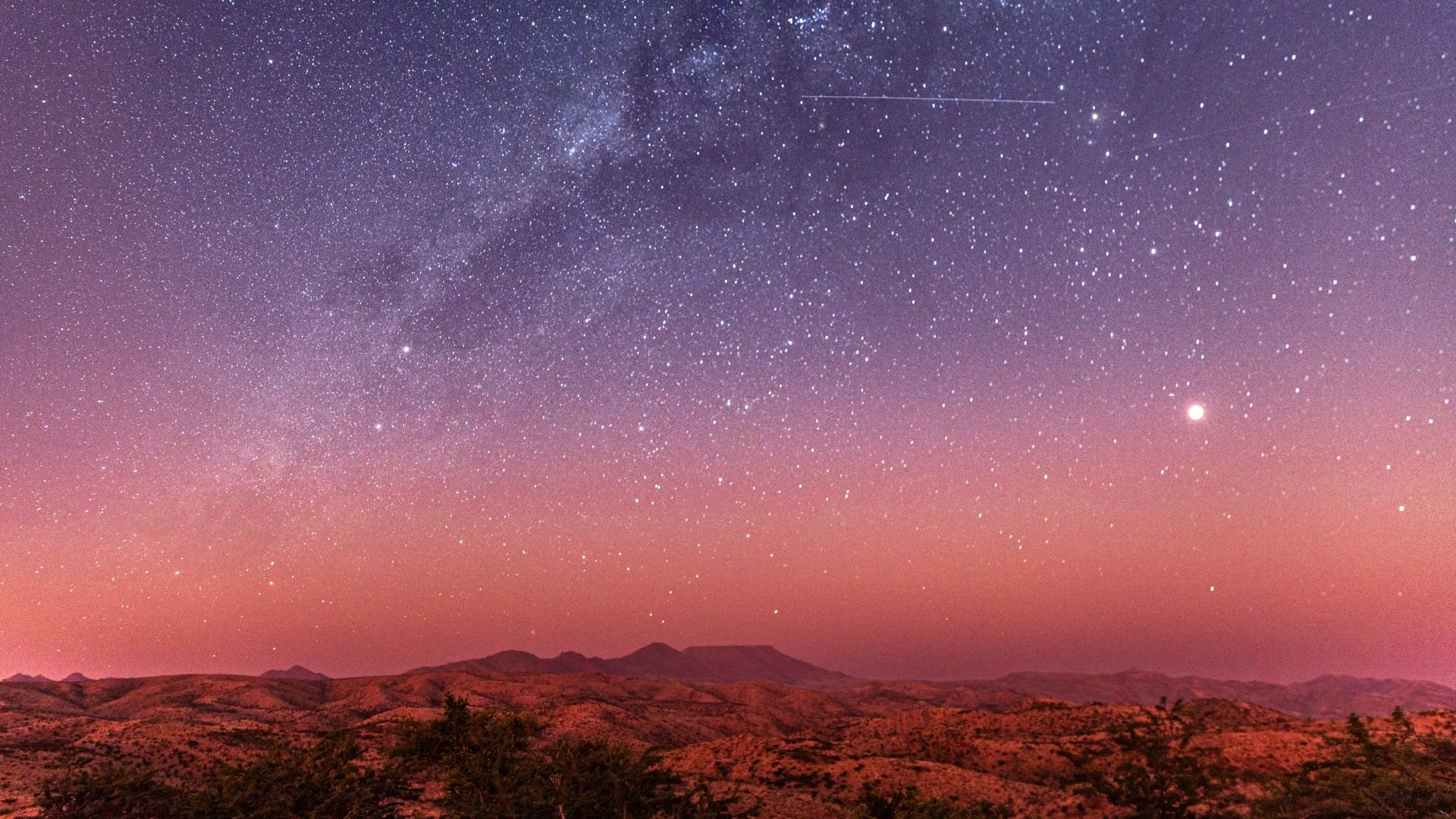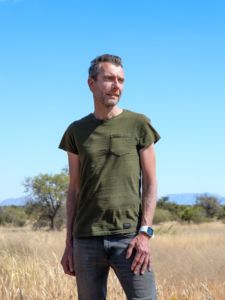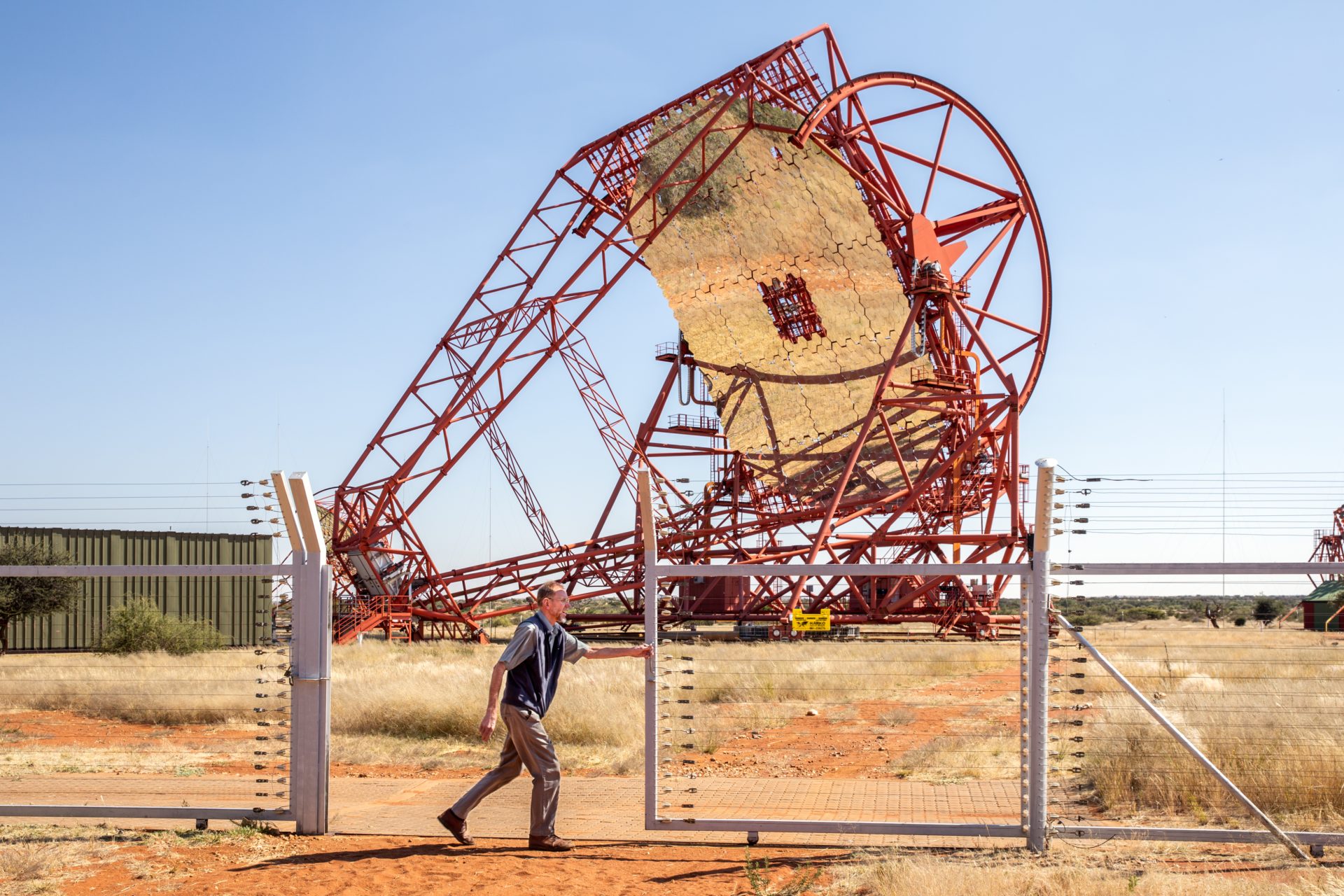Marc Klein Wolt’s crusade for a mega telescope in Namibia
-
 The night sky in Namibia. Photo: Elisa Maenhout
The night sky in Namibia. Photo: Elisa Maenhout
Following the first successful photograph of the black hole at the heart of the Milky Way, astronomers are eager to produce more images, with the help of a new telescope in Africa. Astronomer Marc Klein Wolt has been given the task of siting this telescope on a Namibian mountain. The project is intended to benefit the local population too – but not everyone is enthusiastic. ‘Soon we’ll need permanent surveillance.’
‘Warning!! Big game for the next 12 km. Please drive carefully’, warns a sign on the black steel entrance gate to the road leading to Robin Hurt’s ranch, at the foot of the Gamsberg mountain in Central Namibia. The warning is no exaggeration – less than a minute later two oryx suddenly cross the road in front of us. Later that afternoon, we see white and blue gnus, and springboks, on the tour Hurt gives us of his ten-thousand-hectare estate, in his beige Toyota Hilux. Here he organises photography and hunting safaris for tourists. ‘Your Prince Bernhard was a client of mine in his later years.’
The mini reserve is also home to protected species, such as leopards and cheetahs, which may not be hunted, but are part of a private protection programme. On this isolated site – kilometres away from the main road connecting Windhoek and Walvisbaai – the animals roam freely, safe from potential attackers.
The question is: For how long? Radboud University astronomers are planning to build a large radio telescope on the 2347 metres-high top of the Gamsberg mountain. The road across Hurt’s land is the intended access road. A serious problem, he explains as we sit at his dining-room table, looking out over the dried-up river bed in front of his country house. ‘We’ll soon be living on a main road, accessible to everyone.’ Including poachers, a permanent problem in Namibia. In the first nine months of 2021, nearly 400 people were caught trying to kill protected animal species. ‘We’re worried,’ says Hurt. ‘And communication from the telescope project has been rather poor. They were supposed to send us an update every quarter, but we haven’t heard anything for two years.’
Bizarre phenomena
It was such huge news, on 12 May last year. Astronomers had succeeded in photographing the black hole at the heart of the Milky Way, our solar system’s cosmic home. A blotchy orange donut over 26,000 light years away from the Earth, 4 million times heavier than the Sun. It was only the second such photograph ever, after the ground-breaking 2019 photograph of the black hole in the M87 constellation.
Black holes are some of the most bizarre phenomena in the universe. Their mass and gravity are such that they distort time and space, so that not even light can escape. To photograph a black hole required having eight telescopes around the world, joined into the Event Horizon Telescope (EHT) network, simultaneously pointing at the night sky – as this was the only way to get enough resolution. Professor of Astroparticle Physics Heino Falcke, who was responsible for the original idea, gained international fame with this project.

Now Falcke and his team are ready for the next step. They hope in future to be able to film black holes, and in this way carefully investigate their characteristics and origins. But this requires an extra telescope, adding an additional pixel to the cosmic camera. The Namibian Gamsberg mountain is the ideal location for the project, explains Radboud Astronomer Marc Klein Wolt at a press conference held at the University of Namibia UNAM on 12 May. ‘The atmospheric humidity on the mountain top is low, and EHT still needs a telescope in Southern Africa.’
Within Falcke’s research group, Klein Wolt is the person responsible for realising this Africa Millimetre Telescope (AMT). Radboud University has recently pledged € 12 million to the project. This means that Nijmegen will soon have its ‘own’ telescope, which will strengthen Falcke’s position within the global EHT team. This May, Klein Wolt spent two weeks in Namibia with four Dutch colleagues, in an effort to finalise some important steps: an ideal moment to follow him closely. ‘The AMT can be in place by late 2025,’ says the astronomer. If everything goes according to plan, that is. Apparently, it’s easier to point multiple telescopes in the same direction than it is to get people on the ground thinking the same way.
The logistics challenges alone are stupendous: the mountain top has no running water, electricity, or internet. The only access road is a 3.5 km-long nerve-wrecking cart track full of hairpin bends that takes a four-wheel drive one hour to navigate, and that has been completely washed away during the last rain period. The mountain top is also home to a small rare plant, Euryops walterorum, which could potentially lead to the environmental licence being blocked. And down below there is Hurt and his farming neighbour, neither of whom are looking forward to activity in their backyard.
Lobbyist
The Twente-born and bred Klein Wolt seems made for this Herculean task. He enjoys well-nigh impossible challenges abroad, is energetic, accessible, and has a pragmatic rather than a bureaucratic attitude. Four years ago, he succeeded in getting a Dutch measuring instrument to hitch a ride on a Chinese satellite to the moon. In Namibia, the 47-year old Assistant Professor moves from meeting to meeting like a true lobbyist, talking to government officials, local researchers, lawyers who can help with contracts, and companies that may be interested in making a financial contribution.
But is Namibia as a whole happy with the prospect of the telescope? Ranking 130th on the Human Development Index of the United Nations (UN), the African country seems to have more pressing problems. Plus, the image of Western researchers pinning a flag on the world map to be able to practise their hobby reeks of neocolonialism. Namibia only gained its independence from South Africa in 1990, and it has a complex relationship with another former colonial power, Germany, which was guilty of local genocide. Large areas of Namibia are still in the hands of German descendants, and the Gamsberg mountain top is owned by the Max Planck Institute (MPI).
‘Science always leads to unexpected innovation, which will benefit our whole country’
‘What good is this telescope for Namibia?’ is also the very first question a Namibian journalist asks at the UNAM press conference. ‘This is a telescope in Namibia, and for Namibia,’ answers Klein Wolt. He repeats that the intention is that the entire country will benefit from the project. For example, the telescope will only be needed half of the time for international black hole research; the remainder of the time, it will be at UNAM’s disposal for their own research. The idea is that UNAM will be responsible for managing the telescope, allowing them to train a generation of their own astronomers and technicians. Like Lott Ndeyanale (29), who was able to launch a PhD project within the telescope project, thanks to European funding. A fantastic opportunity, says the young physicist, born in a small village near Ongwediva, towards the Angolan border.
And yet: is this not simply neocolonialism in a scientific disguise? No, the telescope plans should be seen as scientific collaboration and development, says UNAM Vice President Kenneth Matengu. It is not for nothing that Radboud University signed a cooperation covenant with UNAM. ‘Also, science always leads to unexpected innovation, which will benefit our whole country,’ the Vice President says. ‘In future, Namibia hopes to be part of the search for black holes,’ confirms Mekondjo Kaapanda-Girnus, Namibian Ambassador for the Benelux, in a Tweet.
Alternative constellations
Klein Wolt also wants to do something concrete for Namibia, in the form of astronomy lessons. In coming years, an inflatable planetarium will be going around primary and secondary schools throughout Namibia. The 42-year old Joanna Holt, from the Netherlands Research School for Astronomy (NOVA), is training some UNAM students, including PhD candidate Ndeyanale, to give independent presentations, using professional projection equipment also used by Omniversum, in The Hague.
Holt is supported by astronomy student Maaike Pierik (25), for whom the school presentations form the topic of an internship at the Science in Society department. She interviewed Namibian science students about how to make the planetarium presentation most appealing to Namibian children, in terms of the topics covered. ‘We want this project to still be around in 10 years’ time,’ the student explains. One of the plans for the future is also to use the dome to display traditional Namibian knowledge of the night sky, such as the alternative constellations used by some of the local people.

This week, though, Pierik is mostly dealing with practicalities. Contacting schools that have agreed to host a presentation, obtaining permission from the Ministry of Education, putting schedules together; for a Master’s student, she’s managing it all with astonishing ease. What may be helping her with all this is her experience of living in neighbouring Angola as a child, because of her father’s work.
And this is how it comes about that on a Tuesday morning, twenty children in blue-and-white uniforms sit and wait on folding seats in front of a five-metre wide, dome-shaped inflatable tent planted in the middle of the schoolyard of the Jan Jonker secondary school. It’s like an inflatable UFO has landed between the green-white walls of this school in the north of Windhoek, where the smell of briquettes floats across the school grounds from the food stalls down the street.
Once in the dome, all you can hear is ‘Oohs!’ and ‘Ahhs!’, as the Milky Way suddenly unfolds above the children’s heads. Later on, Holt and Ndeyanale display our own solar system on the dome. ‘Mercury, Venus, Earth, Mars…,’ the children chant in chorus. There is no lack of questions, despite the rising heat in the full Namibian autumn sun. ‘If you jump off the international space station, how long does it take before you hit the ground?’ asks Mariam (‘nearly 14’). And: ‘Is there life on Mars?’
The astronomy lesson certainly has added educational value, says Mariam’s physics teacher, Flanan Sikopo. ‘Concepts like the solar system are extremely abstract. Just now, we saw what it all really looks like, which makes it much easier to remember this information. Although it would be good to also be able to link it to problems here on Earth, such as environmental pollution.’
Pain points
Klein Wolt is happy with the planetarium lesson, he says the next day. ‘Getting these lessons up and running was my most important goal this week.’ And yet, not everything is going according to plan. For example, the training programmes are taking longer than expected. And their local partner, an organisation that travels around schools throughout the country with mobile practical lessons, does not always deliver, for example when it comes to organising transportation. The same applies to some of the UNAM people, who in Klein Wolt’s opinion are avoiding discussions with critical farmers near the Gamsberg mountain. ‘This is something that UNAM, in their role as local partner, have to solve. I’m already doing so much for this project.’
A visit to the two local farmers reveals the precise pain points they’re facing. ‘We’re not against the telescope,’ emphasises Robin Hurt from his dining-room table. Neighbours Nicki and Sunja Van Heerden have joined him. ‘But we have the feeling that our objections are low on the list of priorities.’ What they’re most concerned about is poaching and criminal activity. At the moment, says Hurt, he’s relatively safe and under the radar, in a place that’s hard to reach and far from the C26 main road, with no signposting to his estate.
‘Soon we’ll need permanent surveillance; these are ruthless criminal gangs’
This will change once the access road is repaired. And among the dozens of builders working on that road, he says, there’ll always be a few with poachers in their network. ‘Soon we’ll need permanent surveillance; these are ruthless criminal gangs.’ Ideally, he’d like to get some financial compensation, as would his neighbours. Nicki Van Heerden: ‘Now it looks as if everyone is due to profit from the project, from the University to construction companies, except us.’ What’s more, Hurst fears that once traffic increases, some of the tourists will stay away. ‘I heard that they’re even planning to build a hotel on the mountain top. But my guests come here precisely because of the vast emptiness.’
A vastness that is even more palpable on Van Heerden’s farm, 10 km further down the road to the Gamsberg mountain. The unpaved road leading to their site can only be navigated with a four-wheel drive. Nicki: ‘We’re not rich, but we have a good quality of life.’ The farm was purchased in 1928 by Nicki’s grand-father, a white Afrikaner from southern Africa. With his wife, Sunja, the tall forty-something-year-old breeds Bonsmara cows; the family live from the meat and breeding.
Since hearing a few years ago that their access road was to play a key role in the telescope plans, they’ve been in a state of stress. Especially when road workers showed up unannounced one day and started marking places. Nicki: ‘I chased them away.’ At gun-point, according to the road workers. Due to all the uncertainty, among other reasons, the Van Heerden have since put their farm up for sale.
The higher, the better
Couldn’t the telescope be located elsewhere in the country? the farmers wonder. After all, there is so much space in Namibia, the second least populated country in the world. Preferably not, as Klein Wolt explained previously. The higher, the better; that’s the idea. ‘This is how you get lower humidity.’ An important factor, because atmospheric humidity absorbs the radio signal from black holes, the same way sunglasses stop some of the visible light spectrum.
Nevertheless, Klein Wolt and his team are also considering an alternative location: HESS, an astronomy research facility of the German Max Planck Institute, 30 kilometres east of the Gamsberg mountain – but also 500 metres lower. At this location, five red dishes as tall as houses study the high energy radiation originating from supernovas and quasars. Logistically speaking, this location is ideal: electricity, water, and internet are already available, as is an operator’s building. What’s more, the research facility is located on the C26 main road.
‘Yes, this location has everything,’ admits Klein Wolt, as he walks over the grounds with fellow astronomers from UNAN and the South African NW University. ‘It’s also € 6 million cheaper. And behind that hill, the AMT wouldn’t interfere with the measurements of the five other telescopes.’ And still, he would prefer the flat Gamsberg mountain top, as would Professor Heino Falcke. ‘The lower humidity there is ultimately better suited for the kind of research we want to do.’
‘We still have concerns, but we seem to have found a way forward’
But at the end of his working visit to Namibia, Klein Wolt does pay the farmers a visit, after they unexpectedly sent him an email. The conversation is emotional, says Klein Wolt later, but it does thaw the frosty relationships to some extent. Nicki van Heerden refutes the rumour that he chased roadworkers away at gun-point. Complete nonsense, he says adamantly. Klein Wolt also sets some things straight, for example, about a hotel being built at the top of the mountain, that is also a myth.
In addition, he says that the HESS location is being seriously considered as an alternative. May be a larger telescope can compensate for the higher humidity there. But then the Van Heerdens must agree to a temporary measuring instrument on the top of the mountain to determine what the difference is. Nicki and Sunja are happy with this solution, as long as good contractual arrangements are made.
‘We still have concerns, but we seem to have found a way forward’, says Sunja on the telephone a few days after the visit. Robin Hurt informs us by email that he too feels more positive. ‘We’ve all agreed to give the collaboration a fresh start.’
An earlier version of this article appeared in de Volkskrant.




Georg Schurz schreef op 27 september 2022 om 09:41
Thank you for your feedback.
It is better to get directly involved with the Farmers to avoid many unnecessary discussions.